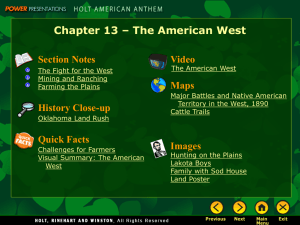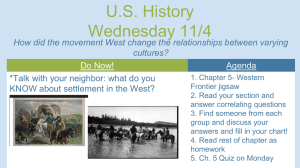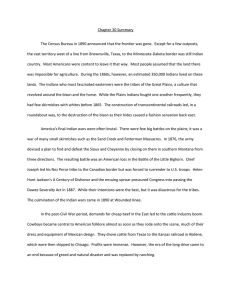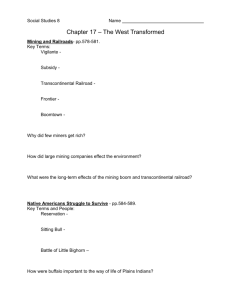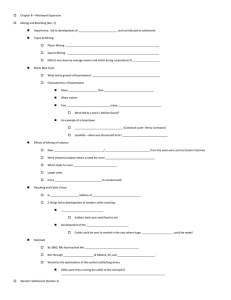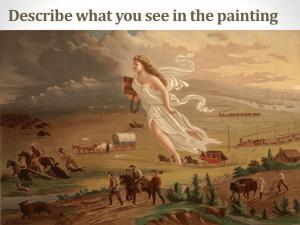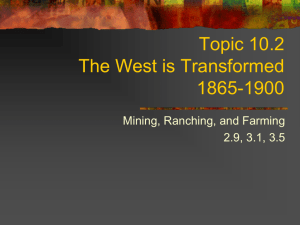The Fight for the West
advertisement
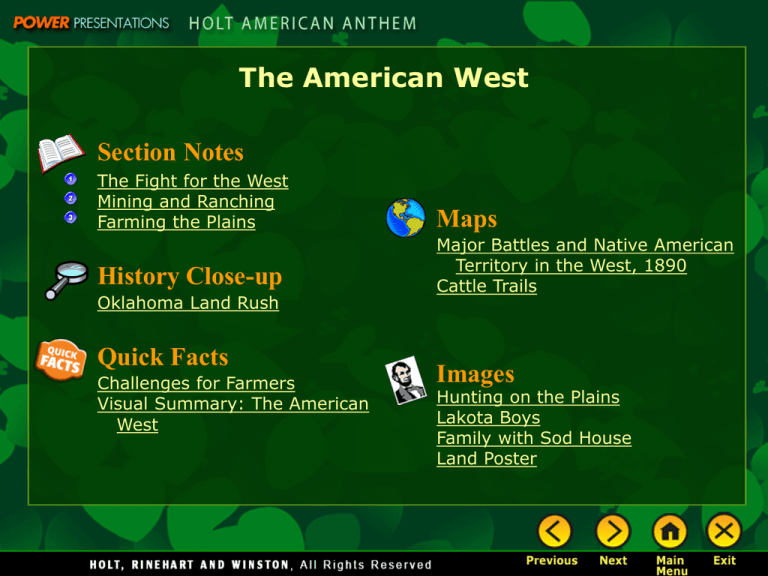
The American West Section Notes The Fight for the West Mining and Ranching Farming the Plains Maps History Close-up Major Battles and Native American Territory in the West, 1890 Cattle Trails Oklahoma Land Rush Quick Facts Challenges for Farmers Visual Summary: The American West Images Hunting on the Plains Lakota Boys Family with Sod House Land Poster The Fight for the West The Main Idea Native Americans fought the movement of settlers westward, but the U.S. military and the persistence of American settlers proved too strong to resist. Reading Focus • How was the stage set for conflict between white settlers and Native Americans in the West? • What were the Indian Wars and their consequences? • How did Native American resistance to white settlement end? • What was life like on the Indian Reservation? Stage Set for Conflict • Culture of the Plains Indians – Buffalo provided food, clothing, and shelter for the nomadic lifestyle of the Indians. They did not believe land should be bought and sold, and white farmers felt it should be divided. • Government policy – Instead of continuing to move the Indians westward, the government changed its policy. Indian land was seized, and they were forced onto reservations. • Destruction of the buffalo – The buffalo-centered way of life was threatened, with vast herds driven to extinction by reduced grazing lands and hunting for sport and profit. The Indian Wars Sand Creek Massacre Army troops attacked and massacred surrendering Cheyenne. Congressional investigators condemned the Army actions, but no one was punished in the Sand Creek Massacre. Treaties After the massacre, Cheyenne and Sioux stepped up their raids. In return for closing a sacred trail, the Sioux agreed to live on a reservation. Other nations signed the Medicine Lodge Treaty and were moved to reservation lands in western Oklahoma. The Battle of the Little Bighorn George Armstrong Custer led his troops in headlong battle against Sitting Bull and lost. The Battle of the Little Bighorn was a temporary victory for the Sioux. The U.S. government was determined to put down the threat to settlers. The Indian Wars Palo Duro Canyon The Ghost Dance Wounded Knee The Battle of Palo Duro Canyon ended the Indian Wars on the southern Plains. With their ponies killed and food stores destroyed, surviving Comanches moved onto the reservation. The Ghost Dance was a religious movement that inspired hope among suffering Native Americans. Newspapers began suggesting that this signaled a planned uprising. The military killed Sitting Bull while attempting to arrest him in a skirmish. The Wounded Knee Massacre occurred the day after the surrender. Shooting began after a gun went off, and the fleeing Sioux were massacred. This action marked the end of the bloody conflict between the army and the Plains Indians. Resistance Ends in the West Resistance in the Northwest • The government took back nine-tenths of the Nez Percé land when gold miners and settlers came into the area. • Fourteen years later they were ordered to abandon the last bit of that land to move into Idaho. • Chief Joseph tried to take his people into Canada, but the army forced their surrender less than forty miles from the Canadian border. • Chief Joseph and many others were eventually sent to northern Washington. Resistance in the Southwest • The Apache people were moved onto a reservation near the Gila River in Arizona. • Soldiers forcefully stopped a religious gathering there, and Geronimo and others fled the reservation. • They raided settlements along the Arizona-Mexico border for years before finally being captured in 1886. • Geronimo and his followers were sent to Florida as prisoners of war. His surrender marked the end of armed resistance in the area. Life on the Reservation The government wanted control over all the western territories and wanted Indians to live like white Americans. The Bureau of Indian Affairs began to erase the Indian culture through a program of Americanization. Indian students could speak only English and could not wear their traditional clothing. They learned to live like Americans. The Dawes Act of 1887 broke up many reservations and turned Native Americans into individual property owners. Ownership was designed to transform their relationship to the land. The Indians received less productive land, and few had the money to start farms. Most of the land given to the Indians was unsuitable for farming. Mining and Ranching The Main Idea Many people sought fortunes during the mining and cattle booms of the American West. Reading Focus • How did mining lead to new settlements in the West? • Why did mining become big business? • How and why did the cattle boom come to an end? Striking Gold and Silver • Discovering gold and silver – After the California gold rush, Colorado was next. Most who went there were disappointed, but the silver in the Comstock Lode in Nevada lasted for more than 20 years. • The Klondike gold rush – The Yukon Territory was the site of a huge gold rush, but getting there was treacherous. Canadians required miners to bring a year’s worth of supplies with them, and that was a difficult task. Reports of “gold for the taking” were false. Development of Communities • Mining camps and towns – Thousands of men poured into mining areas. Camps were hastily built and had no law enforcement. Vigilante justice was used to combat theft and violence. • Camps become towns – Some camps developed into towns, with hastily constructed buildings of stores and saloons. – As towns developed, women and children came to join the men, making the towns more respectable. Townspeople established churches, newspapers, and schools. Mining as Big Business Placer mining allowed individuals to pan for gold, but soon equipment was needed to dig deeper within the earth. Large companies were formed to invest in hydraulic mining and hard-rock mining. Prospectors became employees, working dangerous jobs for these companies. Miners began to organize unions to negotiate safer working conditions and better pay. Mining companies resisted, and violence broke out. At Cripple Creek, Colorado, the Western Federation of Miners faced off against the corporate mining interests. When it was over, 30 men were left dead and the union was defeated. The Cattle Boom Origins of ranching Demand for beef Ranching as big business The Spanish were the first ranchers in the West, raising cattle under dry and difficult conditions. They bred the hardy Texas longhorn and started sheep ranching. Grazing lands were needed for both. Growing populations in the East needed food. The age of the cattle drive had arrived. Cowboys drove the cattle to towns with railroads to be shipped to meatpacking centers such as Chicago. One of the most famous cattle trails was the Chisholm Trail. Joseph Glidden invented barbed wire, allowing ranchers to enclose grazing lands. Privately owned ranches spread quickly, and investors transformed the cattle business into big business. Two years of severe winters brought huge losses to the industry. Farming the Plains The Main Idea The government promoted the settlement of the West, offering free or cheap land to those willing to put in the hard work of turning the land into productive farms. Reading Focus • What incentives encouraged farmers to settle in the West? • Which groups of people moved into the West, and why did they do so? • What new ways of farming evolved in the West? Incentives for Settlement • New legislation – In 1862, Congress passed three acts to turn public lands into private property. • The Homestead Act gave 160 acres of land to heads of household. • The Pacific Railway Act gave land to the railroad companies to build lines. • The Morrill Act gave lands to states for colleges for agriculture and the mechanic arts. Incentives for Settlement • Railroads encourage settlement – Railroads reaped profits by selling some of their land to settlers. They placed ads to lure homesteaders to the West. The Oklahoma Land Run of 1889 opened unassigned Indian land to settlers. Over 50,000 people took part in the rush to stake a claim on these 2 million acres of land. • Closing of the frontier – In 1890 the Census Bureau issued a report, “there can hardly be said to be a frontier line.” Historian Frederick Jackson Turner stated in a famous essay that the existence of the frontier made the United States distinctive. Migrating West White settlers European settlers • Middle-class businesspeople or farmers from the Mississippi Valley moved west. • Lured by economic opportunity, they came from Scandinavia, Ireland, Russia, and Germany. • They could afford money for supplies and transportation. • They brought their farming experience with them. African American settlers • Benjamin Singleton urged his own people to build communities. • Some fled the violent South. • Rumors of land in Kansas brought 15,000 Exodusters who also settled in Missouri, Indiana, and Illinois. Chinese settlers • Initially came for the gold rush or to build railroads • They turned to farming, especially in California, establishing the fruit industry there. • Most Chinese were farm laborers because they were not allowed to own land. New Ways of Farming New farmers faced harsh climate, scarce water, and lack of lumber. Farmers installed windmill-driven pumps and used irrigation techniques. They used the earth for shelter, first building dugouts into hillsides, then making sod houses. New farming equipment helped. James Oliver developed a sharper plow edge. Combine harvesters used one operation to cut wheat, separate grains, and remove the husks. Giant bonanza farms operated like factories, and they reaped great profits during good seasons. However, they could not handle the boom-and-bust farming cycles well, and by the 1890s, most bonanza farms had been broken up.
